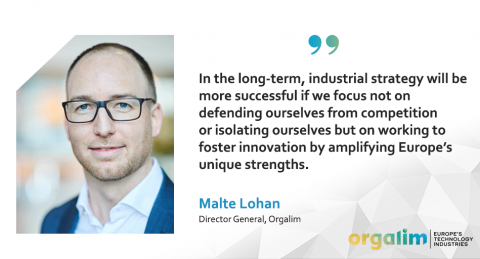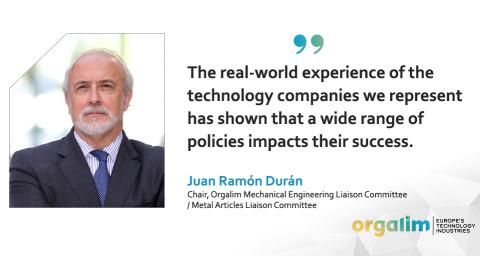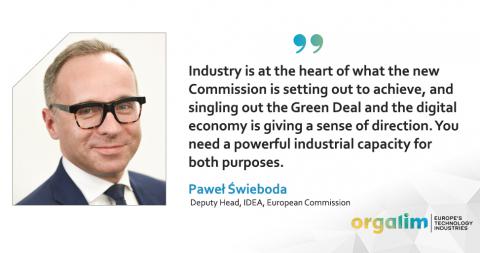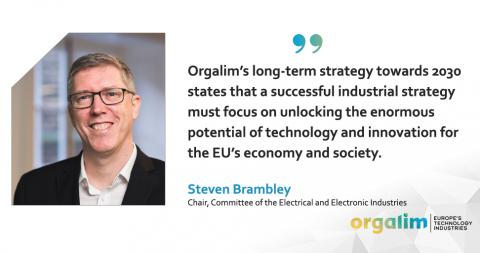Connecting the dots: Finding the right industrial strategy for Europe
17 January 2020
'Connecting the dots' is a new series from Orgalim that takes an in-depth look at the EU policy debates impacting Europe’s technology industries and the ability of these sectors to shape a future that’s good for the EU, its economy and society. In this first edition, we look at how different understandings of EU industry’s position on the global stage are presenting stark choices for policymakers seeking to design a policy strategy to help Europe survive and thrive in the decades ahead.
There is a battle underway for the future of European industry, and it is unfolding on two fronts. On one side looms the rise of China as an economic superpower. Armed with ambitions to become a global technology leader – set out in the ‘Made in China 2025’ strategy – it is muscling in on the high-value-added manufacturing that was traditionally Europe’s turf. And in doing so, it is reviving concerns that the Chinese government is not playing by the rules as we know them, funnelling state money to favoured firms or forcing technology transfers in takeovers of international competitors. On the other side is the long shadow of US dominance in all things digital: a long-standing European insecurity, this increasingly seems an existential question of survival in a world where everything is connected – not only our smartphones but our energy grids, mobility networks and production lines.
At the same time, Europe and indeed the world are facing the unprecedented challenge of a warming planet. For EU industry, the urgency of addressing climate change presents an opportunity: home to many pioneers in green tech, Europe has the potential to lead the global climate transformation in the coming years. The move to a climate-neutral economy will have to be designed so that manufacturers are enabled to find ways to innovate and cut emissions, while continuing to sharpen their competitive edge in the face of this fierce international competition.
How can Europe survive, let alone thrive, in such an increasingly unpredictable global landscape? This is the question policymakers are asking themselves as they debate the future of EU industrial strategy with a vigour not seen for years. Take the sharpened focus on concepts like ‘strategic autonomy’ or ‘technological sovereignty’: in a world of rising geopolitical tensions, the argument goes, Europe must take action to ensure it retains its own technological capacity and does not become overly reliant on other regions. Or the revived debate on the need for ‘European champions’: EU-grown or -made companies on the scale of Chinese manufacturing behemoths or US digital giants. That debate reached new heights last year as France and Germany openly called for a review of EU competition law following a Commission decision to block the merger of Siemens and Alstom: for the Commission, the merger would have undermined competition in the European rail market; for the two national governments, the Commission’s decision was undermining the competitiveness of Europe’s industry in global terms.
Writing a successful future for EU industry starts with the words we use to talk about it... Because as any political scientist will tell you, how you talk about a problem has a big impact on the solutions you look for.
Yet while the gravity of the challenges facing Europe is rarely questioned, some are concerned at these signposts pointing to a new departure in EU industrial strategy. Is there a danger that a legitimate defence of European interests could give way to a new form of protectionism or increased state interventionism? Perhaps there is another way forward – a way to not only stay true to Europe’s values and economic principles, but to use them to enable the very innovation that will make the EU a global leader in its own right.

One coin – two sides
For Malte Lohan, Director General at Orgalim – Europe’s Technology Industries, writing a successful future for EU industry will start with the words we use to talk about it. “In recent years, a political narrative of ‘self-doubt’ has resurfaced around European industry and its capability to address future challenges,” he observes. “In this telling, EU companies lack the necessary scale; our legal and administrative structures are too fragmented and slow to respond; our infrastructure outdated. Europe’s openness to trade has left us overexposed, and digital giants present an existential threat to our established manufacturing strengths.” When viewing the world through this lens, these difficulties are compounded by the challenges presented by climate change, demographic decline and skills shortages – challenges poised to bring a new level of disruption to the European economy.

Yet talk to those actually working in the technology industries across the EU, and another, very different narrative emerges, as Lohan explains: “From the multinational heavy-hitters to booming regional SME ecosystems, our sectors are packed full of self-confident players with little doubt in their ability to compete on the global stage.”
Look at the figures, and you can see where this confidence comes from: Europe’s technology industries have been performing strongly, posting steady year-on-year growth for the last number of years and creating close to 600,000 new jobs between 2014 and 2019. Far from cowed in a defensive stance, these export-driven firms are key links in international value chains. Far from under threat from digital technology, they are themselves driving the digital revolution in industry and beyond – not for nothing did the term ‘Industry 4.0’ originate in the heart of Europe. And far from overwhelmed by the turmoil of a world in flux, they view Europe’s challenges as opportunities to create solutions for future prosperity.
At the heart of this worldview is a belief in the power of innovation – and the power of European industry to be a leader in the global innovation race. Innovation in this understanding is much more than ‘invention’ alone: it is about building on long-standing strengths and know-how, constantly seeking ways to improve and enhance existing technologies to meet new market needs, and finding new connections and insights through collaboration and networks.
In all of these areas, the EU is enviably strong, boasting a long history of industrial innovation and the sort of agile ecosystems that can only emerge through geographical proximity and open markets. Particularly important is the European focus on ‘innovation with a purpose’, a commitment to finding new solutions to the biggest challenges facing society today.
Already, EU industry is leading the charge in technology that lowers emissions, in healthcare and assisted living systems that improve quality of life, in mobility and energy solutions for tomorrow’s cities. A focus on innovation in these areas might sound very noble or altruistic – but in a world where the urgency of these challenges is only growing, it also makes hard-nosed business sense.

For those in the optimists’ camp, the growing political currency of the ‘self-doubt’ narrative is a worrying turn. Because as any political scientist will tell you, how you talk about a problem has a big impact on the kind of solutions you look for. If European industry is well placed to thrive in a changing world, the role of policy should surely be to enable it; if it’s under threat, however, an industrial strategy can quickly become an instrument to defend.

A closer look at industrial strategy
It’s worth taking a step back at this point and asking what exactly we mean when we talk about ‘industrial strategy’. Pinning down a single agreed definition is not so easy, yet Paweł Świeboda, Deputy Head of the European Commission's in-house think tank I.D.E.A. (formerly EPSC), offers a broad definition that works well as a starting point: “Industrial strategy for me is really about value creation in the future, primarily value creation generated by technology,” he explains. “It is an extremely spacious term underneath which you will find a lot of investment tools, research and development tools, competition policy, but also softer measures focused on skills development, for example.”
Depending on the tools chosen, however, the shape industrial strategy takes can vary enormously. And this is where words can matter a great deal. It has often been the case that a more defensive viewpoint (the ‘self-doubt’ narrative described above) aligns with a more ‘interventionist’ policy approach – measures to steer industry development in a particular direction in favour of one sector or technology over another, based on political priorities such as geopolitical insecurity or fear of decline in traditional sectors.

Interventionist policies have come under fire in the past for interfering in free market operation and veering into protectionism: imposing import controls or tariffs, undermining competition law for favoured firms, or overusing state subsidies to gain an international edge. There is little evidence that politicians are particularly good at ‘picking winners’; rather by artificially supporting favoured sectors or companies they reduce incentives for companies to innovate – with all the negative consequences that implies for long-term competitiveness and for the citizens that stand to benefit from that innovation.
In the self-confident narrative, in contrast, the role of an industrial strategy is not to defend but to enable – specifically, to enable the kind of industrial innovation that will be key to Europe’s future success. Libraries have been written about the drivers of innovation, but every book would include as minimum healthy competition, openness to trade and collaboration, and a stable and predictable regulatory framework. In practical terms that means deploying a broad range of horizontal instruments to shape this kind of environment. “The real-world experience of the technology companies we represent has shown that a wide range of policies impacts their success – from Internal Market regulation, digital innovation and trade, to energy, climate and environment legislation,” explains Juan Ramón Durán, Chair of the Orgalim Policy Committee for the mechanical engineering and metalworking branches. “For Orgalim, therefore, ‘industrial strategy’ encompasses the choices made by policymakers across these areas – and a progressive, forward-looking approach is key to enable innovation in companies of all kinds.”

Lessons from the past
Looking back at the history of how EU policy has been used to support industry over the decades, it is characterised by a push-and-pull between these viewpoints. The Treaty of Rome establishing the European Economic Community was firmly market-oriented, focused on eliminating trade barriers and enhancing competition. By the late 1960s, however, concern had grown around a ‘technology gap’ between Europe and the US as American multinationals in fields like ICT began encroaching on the European market. Compounded by the economic slump of the 1970s, many Member State governments began funnelling funding to ‘national champions’ in sectors considered under threat from the US. Yet it soon became clear these policies were ineffective: on the one hand they fragmented the European market further, preventing companies from scaling up; on the other, they sheltered a few chosen firms from international competition, leaving them with little incentives to innovate.
The failure of interventionism led to a policy turnaround in the late 80s and early 90s, underpinned by the renewed confidence of a Europe that, following the fall of the Iron Curtain, was firmly establishing itself as a major economic player on a par with the US. The centrepiece of this new departure was the establishment of the Single Market in 1992. While competition from across the Atlantic and the Far East had not gone away, experience had shown that protectionism was not the answer – rather, trust was put in market forces and opening up to cross-border trade. It paid off: the EU experienced an incredible economic expansion during this period, with the Single Market broadening and deepening to become one of the world’s biggest economies.
In an narrative built on confidence in EU industries strengths, the role of an industrial strategy is not to defend but to enable – to enable the kind of innovation that will be key to Europe’s future success.

At the crossroads
Could the pendulum now be swinging back again? Despite the strong performance of Europe’s technology industries in recent years, the twin spectres of Chinese and US competition are again fuelling fears that the EU is falling behind. The global environment is changing; protectionism is on the rise and Europe’s values of openness and respect for the rules are being taken advantage of by less scrupulous competitors. Listen to the language being used in some corners and it seems many feel that Europe’s only option is to respond in kind: to defend its industries more aggressively, even if this means rolling back on the very strengths that have been key to its industries’ success.
For I.D.E.A.'s Paweł Świeboda, these calls for action should not necessarily be read as a protectionist U-turn. Rather they are a response to real changes in the global landscape, indicating a growing realisation that a new balance needs to be struck: “I think there is a greater understanding in recent years that we need to be both on the offensive and on the defensive – it’s not either/or. Europe’s virtue lies in openness and we have openness to investment written into the treaties. But there are a number of areas where we have allowed ourselves to be played against by others, and these are the windows that we need to close. It’s not about removing competition but about fair competition.”
However, there is a fine line to tread. Attempt to fight fire with fire, warn many in industry, and Europe itself risks getting burned. If the EU pursues a more defensive course, it could end up hitting its own industry hardest: “The reality is that Europe’s industries are now global,” points out Orgalim’s Malte Lohan. “Actions that put up barriers between us and other parts of the world would be very damaging.” Likewise, he points to the thriving SME ecosystem that is the engine of the EU economy: the integrity of the Single Market and open competition have been instrumental in these companies’ success.
And beyond industry, an inward turn could lead to serious fallout for citizens more broadly. Trade conflicts or shrinking competition inevitably push up prices for consumers. Sheltering home-grown firms from the global market means less incentive to innovate – stunting technological progress at a time when it is urgently required to meet society’s evolving needs.


A positive vision for the future
But with protectionism on the rise across the globe and other regions playing by their own rules, what alternative does Europe have? For Malte Lohan, the answer lies in returning to a more confident view of European industry. “While we can’t be naive about current global challenges, the EU needs to avoid knee-jerk reactions that will only compound our difficulties down the road,” he cautions. “In the long-term, industrial strategy will be more successful if we focus not on defending ourselves from competition or isolating ourselves but on working to foster innovation by amplifying Europe’s unique strengths: our commitment to openness and multilateralism, our dynamic collaborative ecosystems, our skilled labour force.” Current discussions around technological sovereignty and strategic value chains must be anchored within this fundamental framework, argues Lohan. And for policymakers, this approach is a win-win: the innovation unleashed can not only boost economic growth, but help deliver on the objectives that matter most to their constituents.
This understanding of the role of industrial innovation in the future of Europe is at the heart of Orgalim’s ‘2030: an industry vision for a renewed Europe’. “This long-term strategy was the result of intensive work involving our membership from right across Europe – speaking for companies big and small, from all sectors of the technology industries,” explains Steven Brambley, Chair of Orgalim’s Policy Committee for the electrical engineering and electronics branch. “The outcome is a truly representative view from Europe’s largest manufacturing branch: stating that a successful industrial strategy must focus on unlocking the enormous potential of technology and innovation for the EU’s economy and society. An enabling framework will be key to that mission.” From this perspective, the tools to enable industry are not to be found in one single box labelled ‘industrial policy’ but rather span measures to leverage industrial innovation across policy fields.
The structure and political priorities of the new Commission indicate that EU policymakers, too, consider industry less as a standalone priority and rather as an integral element across priorities – not a special interest to be protected, but a partner in finding the solutions to shared challenges. “Technology has never been anchored more strongly in the EU agenda than in this forthcoming period,” points out Paweł Świeboda of the EPSC. “Industry is at the heart of what the new Commission is setting out to achieve, and singling out the Green Deal and the digital economy is giving a sense of direction. You need a powerful industrial capacity for both purposes.” The Green Deal is a good example of this thinking in action: described by President von der Leyen as ‘Europe’s new growth strategy’, the measures seek to unlock precisely those synergies between enabling EU global leadership and innovation in service of European values like sustainability.
With policymakers at national and European level facing some critical decisions in the coming months, Orgalim’s Malte Lohan advises changing not only how we talk about industry but how we measure the EU’s success: “We want Europe to be a global leader, but it has to be on our own terms. If we continue defining success by looking to the US and China – do we have the biggest firms, are we the most aggressive, are we winning by rolling over others – where does that leave us? We need instead to measure our success by a simple question: are we helping our industry deliver value for Europe’s society?” Looking to where the biggest opportunities for EU industry will exist in the future, Paweł Świeboda of I.D.E.A. similarly concludes that Europe’s success will lie in beating its own path going forward: “As we consider the fundamental choices ahead, an interesting discussion is emerging about a European ‘third way’ – not to replicate what the US or China has done, but to search for our own model in which technology would be used for a purpose; human-centric and used to address societal challenges from clean energy or health to clean mobility. That’s the real European success story for the next period.”
To get the full picture on Orgalim’s recommendations for the future of European industrial strategy, check out ‘2030: an industry vision for a renewed Europe’. We are currently working on a position paper outlining the views of our sectors on issues like strategic autonomy and technological sovereignty – subscribe to our newsletter for more in the coming weeks. You can find our detailed position papers – on priorities from the Green Deal to AI, trade to the Internal Market – on our website. And if you have any thoughts on the debates discussed in our Connecting the Dots series, we would love to hear from you on Twitter or LinkedIn.
